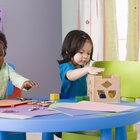Parallel & Reciprocal Play for Toddlers
Playtime with toddlers can leave you wanting a nap just as much as your child. To your youngsters, however, playtime is so much more than silly faces and smeared paint. As young children play, they build their understanding of the world around them, develop their motor skills and learn how to interact with others successfully. Through trial and error, they create their concept of what it means to be human.
Parallel Play
Don't be alarmed when you walk into your child's daycare and find her sitting by herself, cuddling a doll, ignoring a friend a few feet away. No, she is not a loner, and you don't need to worry. She is participating in parallel play. During parallel play, your child explores a toy or activity she has chosen for herself. Once in awhile, she may glance at the other child and mimic one of his actions, such as picking up the same kind of toy. She is noticing what others are doing and giving it a shot herself to see if it's as fun as it looks.
Encouraging Parallel Play

Parallel & Reciprocal Play for Toddlers
Learn More
Though parallel play involves children playing mostly on their own, you can participate by using parallel talk. In other words, watch what your munchkin is doing, and describe it to your child out loud: "You are pushing the car so fast! Beep, beep!" Your toddler may babble in reply as she listens to your words and tone and tries them on for size.
Reciprocal Play
Reciprocal play describes kiddos interacting with others as they play, such as in role-playing or dress-up games. Children engaging in this type of play are coordinating with others to create scenarios for themselves. Reciprocal play generally does not show up until a child is a little older -- around age 3 or 4 is typical, according to Scholastic Parents. You may see your toddler and her friends engage in a few types of simple reciprocal play, such as rolling a ball back and forth or racing riding toys across the floor.
Encouraging Reciprocal Play

How to Make a Kid Keep His Hands Out of His Mouth
Learn More
Break out your running shoes. Keeping up with your child as she begins to engage in reciprocal play is going to take some work, but it gives you many opportunities to build her language skills by using parallel talk as well as self talk -- describing your own actions. Get down on your child's level and ask her how she wants to play. She may say, "Mommy, hold," and hand you a baby doll. Play it up! Rock the doll, pretend to feed it or burp it, and describe your actions. Then hand the toy to your child so she can give it a try. You are validating her interests by giving her your full attention and building her language skills by describing what you are doing.










